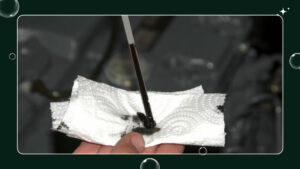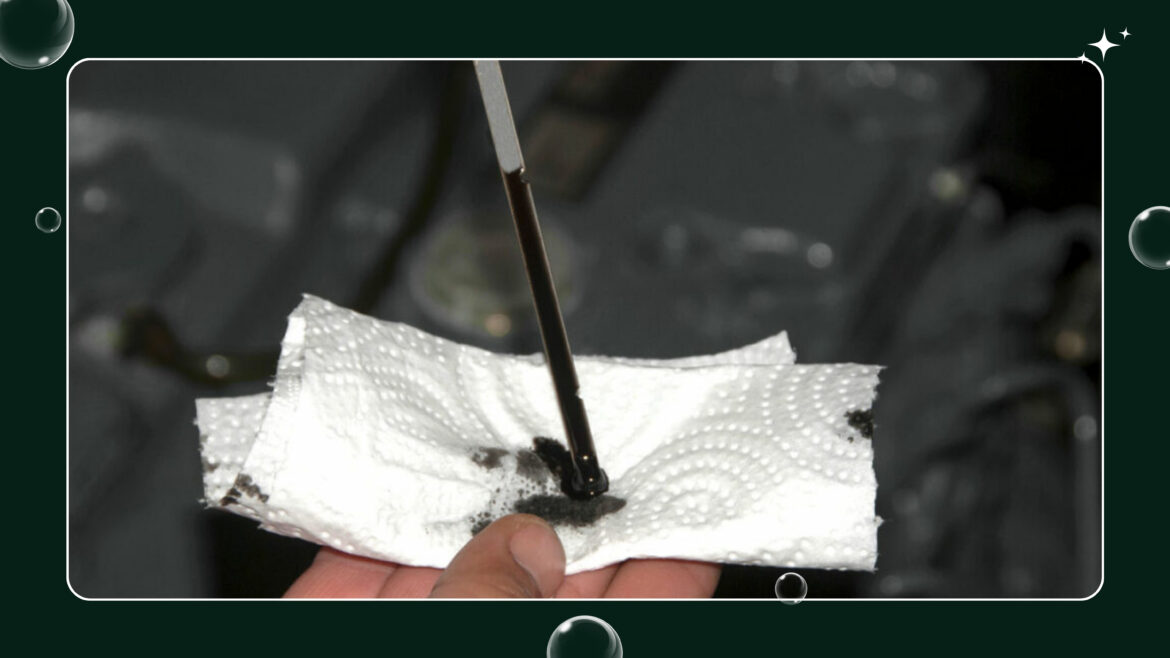
Why do we have dirty oil on our dipstick? (And what causes it?)
It’s a good idea to check your oil every time you fill up. But what do you do with this information? What does dirty oil on the dipstick look like? When is it time for an oil change? You can’t always tell how old your oil is just by looking at it. Here are some signs that your oil has life left and when it should be changed:
Engine oil on the dipstick should appear light to medium brown with no visible contaminants. When you hold the dipstick up to the light, you should be able to see at least a little bit of oil show through. When you drive your car, the oil in your engine is exposed to oxygen during combustion. This exposure to oxygen is called oxidation, the same process that causes rust to form on metal over time. The main cause of engine oil deterioration is oxidation. As engine oil oxidizes, it thickens (becomes more viscous). Over time, deposits and engine sludge are more likely to form in the small passages. Oxidation is accelerated by the extreme heat generated by the combustion process.
Additionally, engine oil and filters absorb dirt and debris that passes through the engine air filter. The oil filter provides a second line of defense against these deposits, preventing contaminants from entering the combustion chamber. Carbon from the combustion process also ends up in the oil. This is why your oil turns black quickly after an oil change.
The image below shows the difference between brand new oil and oil with 10,000 miles on it. Fresh oil is amber in color, similar to honey or very light maple syrup. As you drive, the hydrocarbons in your engine are absorbed into the oil, turning it a light brown color. This process can easily occur in under 100 miles.
Of course, fresh oil will last a lot longer than 100 miles. If the oil is brown but you can still see it clearly through the oil, that’s a good sign that the oil is relatively fresh.
Synthetic oil can last much longer between oil changes than conventional oil. This is because synthetic oil’s components are made at roughly the same size and break down much slower than conventional oil. Synthetic oil is made in one go, while conventional oil is derived from crude oil.
Dirty engine oil is usually opaque, a very dark brown or almost black in color. It is difficult or impossible to see through dirty oil. If the oil is very dirty, you may see small particles or deposits in the oil dipstick. If your engine is old or has premature wear, you may also notice fine sparkles, metal chips, or rust on the dipstick. Metal on the dipstick could be a cause for concern. To investigate this further, you may need to open a used engine oil filter or drain the oil pan.
Oil change intervals vary depending on your car’s engine, the type of engine oil you use, and your driving style. Check your owner’s manual for a good guide to oil change intervals. As a rule of thumb, conventional oil should be changed every 3,000 miles and full synthetic oil every 6,000 miles.
If your vehicle is driven at high speeds, towing heavy loads, or making frequent stops (such as city traffic), you will usually need to change these intervals more quickly. In most cases, full synthetic oil should be changed every 3,000 miles in these difficult driving conditions.
This full synthetic oil has 1,500 miles on it, but it lasts about a year. It is common to have your oil changed annually, even if the mileage is low. This full synthetic oil has a lifespan of about 4,000 miles. Used oil analyses show this oil still has a long useful life.
Some full synthetic oils are designed for long-term use and advertise oil change intervals of up to 20,000 miles. If you are looking to extend your oil change intervals, consider contacting your specific engine oil manufacturer and having them run a series of used oil analyses on the oil coming out of that engine. You should also check your oil every time you refill it to make sure you are not using too much oil. The best way to know when it’s time to change your oil is to have a Used Oil Analysis (UOA). There are several companies that will take an oil sample from your engine and break it down into all of its individual components along with the parts per million (PPM) of each element in the oil.
Blackstone Laboratories is a popular company that tests oils and fuels for elements in the oil, oil viscosity, insolubles in the oil, and oil flash point. The best way to have a used oil analysis performed is to send an oil sample every time you have your oil changed. This will allow a UOA company to determine trends in your engine. For example, if a lab detects a sudden increase in copper levels (an element commonly found in connecting rod bearings), it may be that an engine rebuild is necessary in the near future. If your oil is contaminated with coolant, you may have a leaking head gasket. Which oil to choose is a much-debated topic. Some people insist on a different viscosity than the manufacturer recommends.
Stick to the manufacturer’s recommended oil viscosity unless you have a specific reason to deviate from the recommendation. Modern engines have tighter clearances and can safely run on 5W-30 or even 0W-20 if the engineers designed the engine to your specific specifications.
No matter what oil you choose, check the user manual for API certification. Make sure the oil you choose meets or exceeds these specifications. Diesel oils, such as Shell Rotella T6, contain different additives than motor oils designed for gasoline engines.

